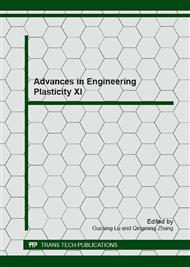p.409
p.413
p.418
p.422
p.426
p.430
p.434
p.441
p.445
The Collapse Characteristics of CFRP Hat-Shaped Sectional Members under Moisture Absorptions Having the Temperature Change
Abstract:
CFRP composite with light weight, high strength, and high elasticity compared to metal is widely used rather than previous steel plates. However, CFRP composite material has the weakness in hygrothermal and impact collapsed environment. Especially, moisture absorption into composite material under hygrothermal environment can change molecule arrangement and chemical properties. Therefore, the purpose of this study lies in acquiring quantitative design data that can be put into the practice by comparing and evaluating the strength degradation under the environment where the moisture is absorbed by conducting static and impact collapse test after setting extreme condition for CFRP composite that takes consistent form such as frontal side members that is actually used in vehicle. This study compared and studied change in the progress of a moisture absorption ratio after setting up the temperature of 60 degrees, and 80 degrees in order to comprehend how the change in the temperature impacts on moisture absorption status inside CFRP composite materials. As a result of this study showed that the strength reduction of about 50% appears due to moisture absorptions. In addition, it showed that the higher the temperature is, the more rapid the progress of a moisture absorption inside CFRP composite materials is. Accordingly, it showed that the change in matrix also has a weak point.
Info:
Periodical:
Pages:
426-429
Citation:
Online since:
January 2013
Authors:
Price:
Сopyright:
© 2013 Trans Tech Publications Ltd. All Rights Reserved
Share:
Citation:


